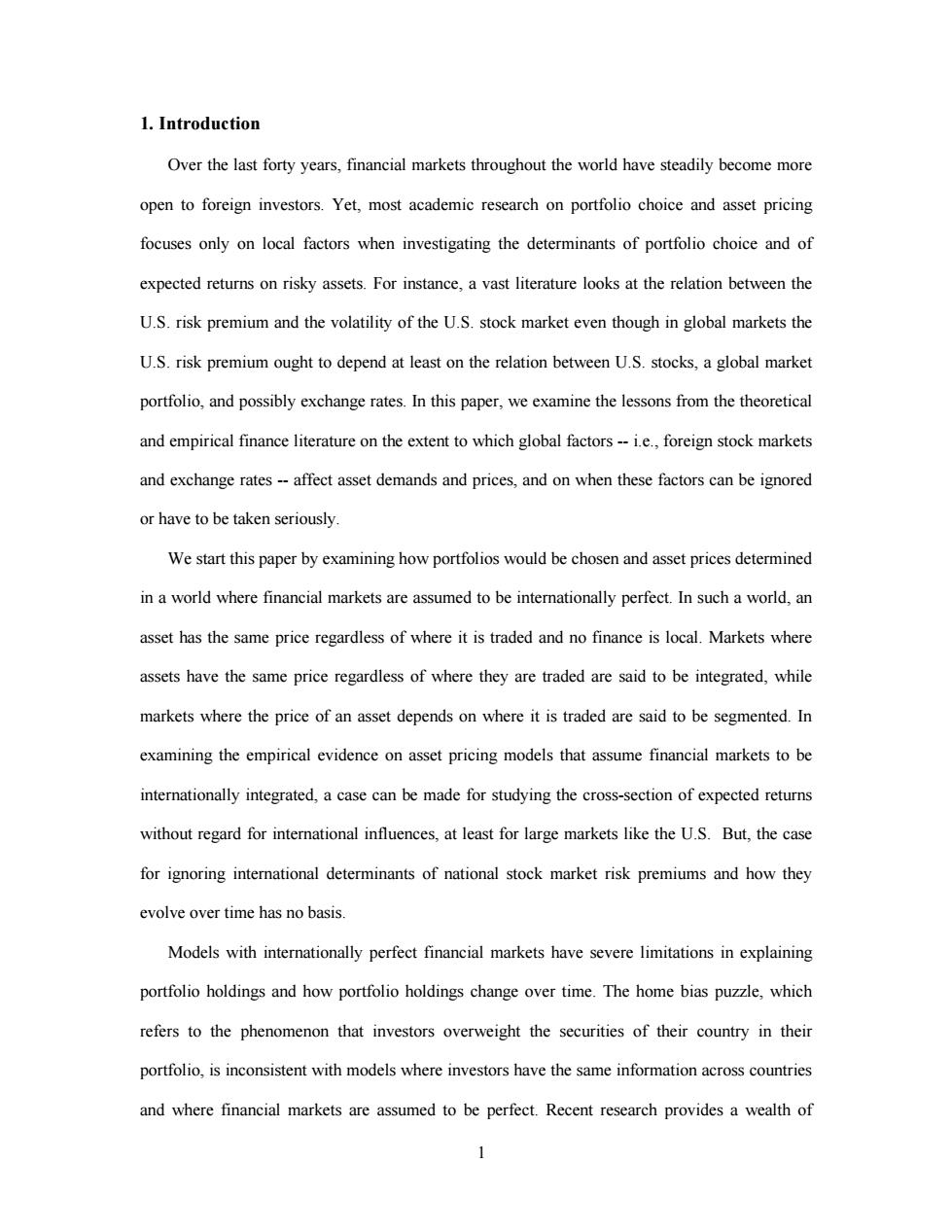正在加载图片...

1.Introduction Over the last forty years,financial markets throughout the world have steadily become more open to foreign investors.Yet,most academic research on portfolio choice and asset pricing focuses only on local factors when investigating the determinants of portfolio choice and of expected returns on risky assets.For instance,a vast literature looks at the relation between the U.S.risk premium and the volatility of the U.S.stock market even though in global markets the U.S.risk premium ought to depend at least on the relation between U.S.stocks,a global market portfolio,and possibly exchange rates.In this paper,we examine the lessons from the theoretical and empirical finance literature on the extent to which global factors--i.e.,foreign stock markets and exchange rates--affect asset demands and prices,and on when these factors can be ignored or have to be taken seriously. We start this paper by examining how portfolios would be chosen and asset prices determined in a world where financial markets are assumed to be internationally perfect.In such a world,an asset has the same price regardless of where it is traded and no finance is local.Markets where assets have the same price regardless of where they are traded are said to be integrated,while markets where the price of an asset depends on where it is traded are said to be segmented.In examining the empirical evidence on asset pricing models that assume financial markets to be internationally integrated,a case can be made for studying the cross-section of expected returns without regard for international influences,at least for large markets like the U.S.But,the case for ignoring international determinants of national stock market risk premiums and how they evolve over time has no basis. Models with internationally perfect financial markets have severe limitations in explaining portfolio holdings and how portfolio holdings change over time.The home bias puzzle,which refers to the phenomenon that investors overweight the securities of their country in their portfolio,is inconsistent with models where investors have the same information across countries and where financial markets are assumed to be perfect.Recent research provides a wealth of 11 1. Introduction Over the last forty years, financial markets throughout the world have steadily become more open to foreign investors. Yet, most academic research on portfolio choice and asset pricing focuses only on local factors when investigating the determinants of portfolio choice and of expected returns on risky assets. For instance, a vast literature looks at the relation between the U.S. risk premium and the volatility of the U.S. stock market even though in global markets the U.S. risk premium ought to depend at least on the relation between U.S. stocks, a global market portfolio, and possibly exchange rates. In this paper, we examine the lessons from the theoretical and empirical finance literature on the extent to which global factors -- i.e., foreign stock markets and exchange rates -- affect asset demands and prices, and on when these factors can be ignored or have to be taken seriously. We start this paper by examining how portfolios would be chosen and asset prices determined in a world where financial markets are assumed to be internationally perfect. In such a world, an asset has the same price regardless of where it is traded and no finance is local. Markets where assets have the same price regardless of where they are traded are said to be integrated, while markets where the price of an asset depends on where it is traded are said to be segmented. In examining the empirical evidence on asset pricing models that assume financial markets to be internationally integrated, a case can be made for studying the cross-section of expected returns without regard for international influences, at least for large markets like the U.S. But, the case for ignoring international determinants of national stock market risk premiums and how they evolve over time has no basis. Models with internationally perfect financial markets have severe limitations in explaining portfolio holdings and how portfolio holdings change over time. The home bias puzzle, which refers to the phenomenon that investors overweight the securities of their country in their portfolio, is inconsistent with models where investors have the same information across countries and where financial markets are assumed to be perfect. Recent research provides a wealth of